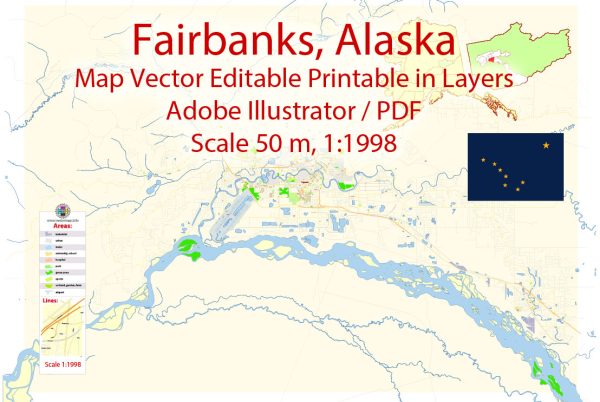Fairbanks, Alaska, located in the heart of the state’s interior, has a rich history that reflects the challenges and opportunities associated with the American frontier. Here is a brief description of the history of Fairbanks, Alaska:
- Early Indigenous Inhabitants: Before the arrival of European settlers, the region was inhabited by Indigenous Athabascan people, such as the Tanana Athabascans. They relied on hunting, fishing, and gathering for their sustenance in the harsh subarctic environment.
- Discovery of Gold: Fairbanks’ history is closely tied to the discovery of gold. In 1902, gold was discovered in the nearby Cleary Creek, leading to a rush of prospectors into the area. A town was established on the banks of the Chena River to support these miners. The town was named after Charles W. Fairbanks, who was a U.S. Senator and later Vice President of the United States.
- Growth and Development: Fairbanks grew rapidly as miners and entrepreneurs settled in the area. It became a center for the gold mining industry in the early 20th century, and a transportation hub with the construction of the Alaska Railroad. The development of the city was further accelerated during World War II when the U.S. military built the Ladd Army Airfield to support the war effort in the Pacific.
- Military Presence: The city has maintained a significant military presence over the years, with both Fort Wainwright and Eielson Air Force Base located nearby. These bases have played a crucial role in Fairbanks’ economy and contributed to its growth.
- Alaska Statehood: Alaska achieved statehood in 1959, and Fairbanks was a vital part of the new state’s development. The city’s location made it a key transportation and supply center for Alaska’s vast interior region.
- Economic Activities: Over time, Fairbanks diversified its economy beyond gold mining to include industries like agriculture, education, and government services. The city’s university, the University of Alaska Fairbanks, has played a significant role in education and research in the state.
- Tourism and Outdoor Recreation: Fairbanks has also become a hub for tourism, attracting visitors with its unique attractions, such as the Northern Lights, hot springs, and opportunities for outdoor activities like dog sledding and ice fishing.
- Cultural Diversity: Fairbanks is home to a diverse population that includes Native Alaskans, military personnel, and residents from all over the United States and the world. This diversity has contributed to the city’s vibrant cultural scene.
- Challenges and Resilience: Fairbanks faces challenges due to its remote location, extreme weather, and a delicate environmental balance. Climate change and its impact on the region are of increasing concern.
Fairbanks, Alaska’s history is a story of exploration, resource extraction, and adaptation to the unique demands of life in the far north. It continues to be an important city in Alaska, known for its distinctive culture and resilience in the face of harsh environmental conditions.


 Author: Kirill Shrayber, Ph.D.
Author: Kirill Shrayber, Ph.D.